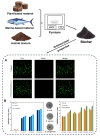Biochar Utilization in Antimicrobial, Anticancer, and Biosensing Applications: A Review
- PMID: 40563402
- PMCID: PMC12190419
- DOI: 10.3390/biom15060760
Biochar Utilization in Antimicrobial, Anticancer, and Biosensing Applications: A Review
Abstract
Biochar, a carbonaceous material derived from biomass, has garnered significant attention for its biomedical applications due to its unique physicochemical properties. Recent advances in functionalized and composite biochar materials have enabled their use in antibacterial and anticancer treatments, as well as biosensing technologies. This review highlights recent advances in the use of biochar for antimicrobial, anticancer, and biosensing applications. Derived from plant-, marine-, or animal-based biomass through pyrolysis, biochar can be functionalized with silver nanoparticles, metal oxides, or polymers to enhance its antimicrobial activity. In anticancer research, biochar demonstrates the ability to inhibit cancer cell proliferation, modulate the cell cycle, and deliver targeted therapeutics, showing selective cytotoxicity against specific cancer cell types. Furthermore, biochar-based biosensors, when integrated with biomolecules such as enzymes, DNA, or antibodies, exhibit high sensitivity and specificity, making them suitable for precise disease diagnostics. These findings suggest that biochar holds significant potential as a sustainable biomedical material, offering alternatives to conventional antibiotics, supporting cancer therapy, and enabling sensitive biosensing platforms. Future functionalization strategies may further facilitate its clinical translation and practical applications.
Keywords: antibiotics; anticancer; biochar; biomedical application; biosensor.
Conflict of interest statement
The authors declare no conflicts of interest.
Figures







Similar articles
-
Topotecan, pegylated liposomal doxorubicin hydrochloride and paclitaxel for second-line or subsequent treatment of advanced ovarian cancer: a systematic review and economic evaluation.Health Technol Assess. 2006 Mar;10(9):1-132. iii-iv. doi: 10.3310/hta10090. Health Technol Assess. 2006. PMID: 16545208
-
Engineered Nanoparticles with Antimicrobial Property.Curr Drug Metab. 2017;18(11):1040-1054. doi: 10.2174/1389200218666170925122201. Curr Drug Metab. 2017. PMID: 28952436
-
Cost-effectiveness of using prognostic information to select women with breast cancer for adjuvant systemic therapy.Health Technol Assess. 2006 Sep;10(34):iii-iv, ix-xi, 1-204. doi: 10.3310/hta10340. Health Technol Assess. 2006. PMID: 16959170
-
Home treatment for mental health problems: a systematic review.Health Technol Assess. 2001;5(15):1-139. doi: 10.3310/hta5150. Health Technol Assess. 2001. PMID: 11532236
-
EORTC guidelines for the use of erythropoietic proteins in anaemic patients with cancer: 2006 update.Eur J Cancer. 2007 Jan;43(2):258-70. doi: 10.1016/j.ejca.2006.10.014. Epub 2006 Dec 19. Eur J Cancer. 2007. PMID: 17182241
References
-
- Liang L.P., Xi F.F., Tan W.S., Meng X., Hu B.W., Wang X.K. Review of organic and inorganic pollutants removal by biochar and biochar-based composites. Biochar. 2021;3:255–281. doi: 10.1007/s42773-021-00101-6. - DOI
-
- Van Zwieten L., Kimber S., Morris S., Chan K.Y., Downie A., Rust J., Joseph S., Cowie A. Effects of biochar from slow pyrolysis of papermill waste on agronomic performance and soil fertility. Plant Soil. 2010;327:235–246. doi: 10.1007/s11104-009-0050-x. - DOI
Publication types
MeSH terms
Substances
Grants and funding
LinkOut - more resources
Full Text Sources

